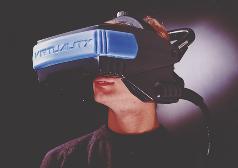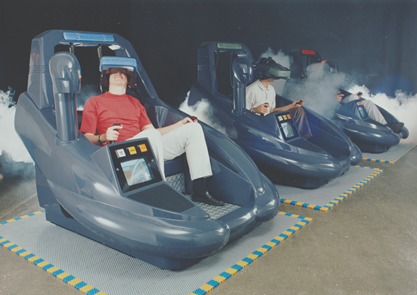A Report on the presentation by W.Industries.
© Chris Hand, 1991
THE RISE OF W.INDUSTRIES
Terry Rowley next turned his attention to the history of the company of which he is Simulation Director: W.Industries of Leicester, UK. The early work was due to Jonathan Waldern at Leicester Polytechnic, who worked there with Professor Edmonds in the HCI research unit (which later moved to Loughborough University). A video clip from an early 80's episode of the BBC TV programme "Tomorrow's World" showed some of the early work of Dr Waldern.

The "Roaming Caterpillar" (as it was known - right) was shown being used by presenter Maggie Philbin to examine a virtual room. The display was a large B/W monitor with handles on each side, supported by a flexible arm on castors covered by a concertina of rubber (the "caterpillar"). The image displayed was a wire-frame view of the "contents" of the (actually empty) room. The location of the monitor was sensed by 3 fixed speakers emitting audible clicks in a fixed sequence, with the time taken to reach microphones being used to calculate the distance. It was also possible to detect the position of the user's fingers by wearing tubes on them, with microphones and wires attached to a control unit. By pinching her fingers together in the right place, the presenter picked up the receiver of a virtual telephone and left it suspended in space. A stereoscopic view of the room was also possible by wearing a head- mounted visor with a rotating shutter, a separate image being presented to each eye on alternate frames of the video image. Although slow at the time, this system allowed further experimentation.

John Waldern was joined by Al Humrich – another colleague with expertise in graphics - and then Richard Holmes (an ex-Rolls Royce employee) and Terry Rowley from Marconi. These four decided to put their money where their mouths were, and in October 1987 founded W Industries. Although the four had to start by constructing equipment in their garages, by January 1989 they acquired and moved into their own premises. They started with a head-mounted display, tethered at the top, with handles on a small screen (LCD?). This version didn't get very far off the drawing board.

Their second HMD, another tethered system, was known as the "giraffe". This featured mechanical 2D head-tracking. Some games were written that used the device. Mr Rowley showed a slide featuring a white plastic unit, not entirely unlike a giraffe (!), with the wearer reaching out into virtual space (despite the lack of a hand-tracking device). The legend on the side of the arm read "W Industries 3d vids".
The fourth device to be built was much slimmer, featuring a magnetic head-tracker and twin LCD screens. It is of interest to note that the head-mounted part of the device allowed for adjustment of inter-ocular spacing. At the time it was thought that the correct adjustment of this distance to suit each viewer would be vital to the stereoscopic effect. Mr Rowley pointed out that it was later found not to be so important, as long as the exit pupil of the optics was made large enough.

The fifth head-mounted display/tracker is the current W industries system as seen in many a smoke-filled publicity photograph (see later for details).
In early 1989 W Industries received an award for "best emerging technology" which brought a prize of GBP £20,000 and, just as important, a good deal of publicity. They were approached by a large leisure firm who bought 75% of their equity. This gave the leisure firm majority control, but the resulting input of 1 million pounds was greatly needed. In November 1990 the "Stand-Up" unit was launched at the Computer Graphics 90 exhibition staged at London's Alexandra Palace. At the same time the parent company went into liquidation, but fortunately W Industries had been sold just prior to this to another company, which also owns the Wembley Stadium in London.

The "Sit-Down" unit was launched, at Wembley, in March 1991. With ever-gathering momentum, WI moved into their own premises of 22,000 square feet in an industrial park in Leicester in May 1991. These premises are still (were) only partly occupied and are currently used for development, assembly and testing of the units, known as "Virtuality".


